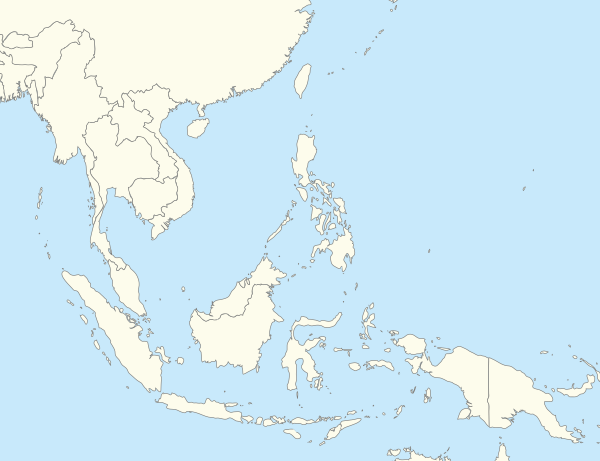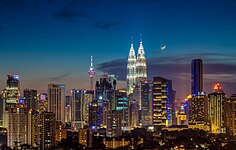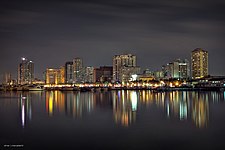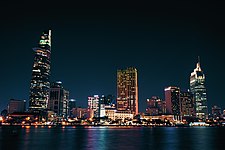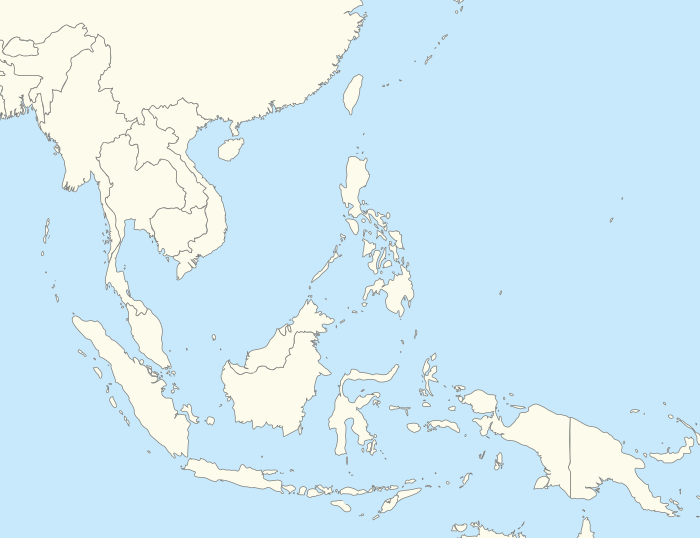Southeast Asia
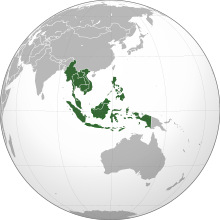 Geopolitical map of Southeast Asia, including Western New Guinea, which is geographically part of Oceania | |
| Area | 4,545,792 km2 (1,755,140 sq mi) |
|---|---|
| Population | 675,796,065 (3rd)[1][2] |
| Population density | 135.6/km2 (351/sq mi) |
| GDP (PPP) | $9.727 trillion[3] |
| GDP (nominal) | $3.317 trillion (exchange rate)[4] |
| GDP per capita | $5,017 (exchange rate)[4] |
| HDI | |
| Ethnic groups |
|
| Religions | Animism, Buddhism, Christianity, Confucianism, Hinduism, Islam, Tai folk religion, Taoism, and Vietnamese folk religion |
| Demonym | Southeast Asian |
| Countries | |
| Dependencies | |
| Languages | Official languages Other languages
|
| Time zones | 5 time zones
|
| Internet TLD | .bn, .id, .kh, .la, .mm, .my, .ph, .sg, .th, .tl, .vn |
| Calling code | Zone 6, 8 & 9 |
| Largest cities | Capital cities Largest cities
|
| UN M49 code | 035 – South-eastern Asia142 – Asia001 – World |
Southeast Asia
The region lies near the intersection of geological plates, with both heavy seismic and volcanic activities.[6] The Sunda Plate is the main plate of the region, featuring almost all Southeast Asian countries except Myanmar, northern Thailand, northern Laos, northern Vietnam, and northern Luzon of the Philippines, while the Sunda Plate only includes western Indonesia to as far east as the Indonesian province of Bali. The mountain ranges in Myanmar, Thailand, Peninsular Malaysia and the Indonesian islands of Sumatra, Java, Bali, Lesser Sunda Islands, and Timor are part of the Alpide belt, while the islands of the Philippines and Indonesia as well as East Timor are part of the Pacific Ring of Fire. Both seismic belts meet in Indonesia, causing the region to have relatively high occurrences of earthquakes and volcanic eruptions, particularly in the Philippines and Indonesia.[7]
It covers about 4,500,000 km2 (1,700,000 sq mi), which is 8% of Eurasia and 3% of Earth's total land area. Its total population is more than 675 million, about 8.5% of the world's population. It is the third most populous geographical region in Asia after South Asia and East Asia.[8] The region is culturally and ethnically diverse, with hundreds of languages spoken by different ethnic groups.[9] Ten countries in the region are members of the Association of Southeast Asian Nations (ASEAN), a regional organisation established for economic, political, military, educational, and cultural integration among its members.[10]
Southeast Asia is one of the most culturally diverse regions of the world. There are many different languages and ethnicities in the region. Historically, Southeast Asia was significantly influenced by
Definition

The region, together with part of South Asia, was well known by Europeans as the East Indies or simply the Indies until the 20th century. Chinese sources referred the region as Nanyang ("南洋"), which literally means the "Southern Ocean". The mainland section of Southeast Asia was referred to as Indochina by European geographers due to its location between China and the Indian subcontinent and its having cultural influences from both neighbouring regions. In the 20th century, however, the term became more restricted to territories of the former French Indochina (Cambodia, Laos, and Vietnam). The maritime section of Southeast Asia is also known as the Malay Archipelago, a term derived from the European concept of a Malay race.[13] Another term for Maritime Southeast Asia is Insulindia (Indian Islands), used to describe the region between Indochina and Australasia.[14]
The term "Southeast Asia" was first used in 1839 by American pastor Howard Malcolm in his book Travels in South-Eastern Asia. Malcolm only included the Mainland section and excluded the Maritime section in his definition of Southeast Asia.[15] The term was officially used in the midst of World War II by the Allies, through the formation of South East Asia Command (SEAC) in 1943.[16] SEAC popularised the use of the term "Southeast Asia", although what constituted Southeast Asia was not fixed; for example, SEAC excluded the Philippines and a large part of Indonesia while including Ceylon. However, by the late 1970s, a roughly standard usage of the term "Southeast Asia" and the territories it encompasses had emerged.[17] Although from a cultural or linguistic perspective the definitions of "Southeast Asia" may vary, the most common definitions nowadays include the area represented by the countries (sovereign states and dependent territories) listed below.
Ten of the eleven states of Southeast Asia are members of the Association of Southeast Asian Nations (ASEAN), while East Timor is an observer state. Papua New Guinea has stated that it might join ASEAN, and is currently an observer. Sovereignty issues exist over some islands in the South China Sea.
Political divisions
Sovereign states
| State | Area (km2) |
Population
(2020)[18] |
Density (/km2) |
GDP (nominal), billion USD (2022)[4] |
GDP (PPP), billion Int$ (2022)[4] |
GDP (nominal) per capita, USD (2022)[4] |
GDP (PPP) per capita, Int$ (2022)[4] |
HDI (2021)[19] |
Capital |
|---|---|---|---|---|---|---|---|---|---|
| 5,765[20] | 449,002 | 77 | 16.639 | 31.142 | $37,667 | $70,500 | 0.829 | Bandar Seri Begawan | |
| 181,035[21] | 16,718,965 | 92 | 28.544 | 89.570 | $1,784 | $5,600 | 0.593 | Phnom Penh | |
| 14,874[22] | 1,320,942 | 89 | 3.659 | 7.502 | $2,671 | $5,478 | 0.607 | Dili | |
| 1,904,569[23] | 273,753,191 | 144 | 1,318.807 | 4,036.878 | $4,798 | $14,687 | 0.705 | Jakarta | |
| 236,800[24] | 7,425,057 | 31 | 15.304 | 68.843 | $2,046 | $9,207 | 0.607 | Vientiane | |
| 329,847[25] | 33,573,874 | 102 | 407.923 | 1,134.671 | $12,364 | $34,391 | 0.803 | Kuala Lumpur * | |
| 676,578[26] | 53,798,084 | 80 | 56.757 | 261.170 | $1,053 | $4,846 | 0.585 | Nay Pyi Taw
| |
| 300,000[27] | 115,559,009 | 380 | 404.261 | 1,171.162 | $3,623 | $10,497 | 0.699 | Manila | |
| 719.2[28] | 5,921,231 | 8,261 | 466.789 | 719.080 | $82,807 | $127,563 | 0.939 | Singapore | |
| 513,120[29] | 71,601,103 | 140 | 536.160 | 1,482.347 | $7,650 | $21,152 | 0.800 | Bangkok | |
| 331,210[30] | 97,468,029 | 294 | 406.452 | 1,321.249 | $4,086 | $13,283 | 0.703 | Hanoi |
* Administrative centre in Putrajaya.

Geographical divisions
Southeast Asia is geographically divided into two subregions, namely Mainland Southeast Asia (or the Indochinese Peninsula) and Maritime Southeast Asia.
Mainland Southeast Asia includes:
- Cambodia, Laos and Vietnam:
- Myanmar, Thailand and West Malaysia:
Maritime Southeast Asia includes:
While Peninsular Malaysia is geographically situated in Mainland Southeast Asia, it shares many similar cultural and ecological affinities with surrounding islands, thus it is often grouped with them as part of Maritime Southeast Asia.[33] Geographically, the Andaman and Nicobar Islands of India is also considered a part of Maritime Southeast Asia. Eastern Bangladesh and Northeast India have strong cultural ties with Mainland Southeast Asia and are sometimes considered transregional areas between South Asia and Southeast Asia.[34] To the east, Hong Kong is sometimes regarded as part of Southeast Asia.[35][36][37][38][39][40][41] Similarly, Christmas Island and the Cocos (Keeling) Islands have strong cultural ties with Maritime Southeast Asia and are sometimes considered transregional areas between Southeast Asia and Australia/Oceania. On some occasions, Sri Lanka has been considered a part of Southeast Asia because of its cultural and religious ties to Mainland Southeast Asia.[17][42] The eastern half of the island of New Guinea, which is not a part of Indonesia, namely, Papua New Guinea, is sometimes included as a part of Maritime Southeast Asia, and so are Guam, the Northern Mariana Islands, and Palau, which were all parts of the Spanish East Indies with strong cultural and linguistic ties to the region, specifically, the Philippines.[43]
East Timor and the eastern half of Indonesia (east of the Wallace Line in the region of Wallacea) are considered to be geographically associated with Oceania due to their distinctive faunal features. Geologically, the island of New Guinea and its surrounding islands are considered as parts of the Australian continent, connected via the Sahul Shelf. Both Christmas Island and the Cocos (Keeling) Islands are located on the Australian Plate, south of the Sunda Trench. Even though they are geographically closer to Maritime Southeast Asia than mainland Australia, these two Australian external territories are not geologically associated with Asia as none of them is actually on the Sunda Plate. The UN Statistics Division's geoscheme, which is a UN political geography tool created specifically for statistical purposes,[44] has classified both island territories as parts of Oceania, under the UNSD subregion "Australia and New Zealand" (Australasia). Some definitions of Southeast Asia may include Taiwan. Taiwan has sometimes been included in Southeast Asia as well as East Asia but is not a member of ASEAN.[45] Likewise, a similar argument could be applied to some southern parts of mainland China, as well as Hong Kong and Macau, may also considered as part of Southeast Asia as well as East Asia but are not members of ASEAN.[35]
History
Prehistory

The region was already inhabited by
Ancient remains of hunter-gatherers in Maritime Southeast Asia, such as one Holocene hunter-gatherer from South Sulawesi, had ancestry from both the Papuan-related and East Asian-related branches of the Eastern non-African lineage. The hunter-gatherer individual had approximately ~50% "Basal-East Asian" ancestry, and was positioned in between modern East Asians and Papuans of Oceania. The authors concluded that East Asian-related ancestry expanded from Mainland Southeast Asia into Maritime Southeast Asia much earlier than previously suggested, as early as 25,000BC, long before the expansion of Austroasiatic and Austronesian groups.[51]
Distinctive Basal-East Asian (East-Eurasian) ancestry was recently found to have originated in Mainland Southeast Asia at ~50,000BC, and expanded through multiple migration waves southwards and northwards respectively. Geneflow of East Asian-related ancestry into Maritime Southeast Asia and Oceania could be estimated to ~25,000BC (possibly also earlier). The pre-Neolithic Papuan-related populations of Maritime Southeast Asia were largely replaced by the expansion of various East Asian-related populations, beginning about 50,000BC to 25,000BC years ago from Mainland Southeast Asia. The remainders, known as Negritos, form small minority groups in geographically isolated regions. Southeast Asia was dominated by East Asian-related ancestry already in 15,000BC, predating the expansion of Austroasiatic and Austronesian peoples.[48]
In the late
The
Studies presented by the Human Genome Organisation (HUGO) through genetic studies of the various peoples of Asia show empirically that there was a single migration event from Africa, whereby the early people travelled along the south coast of Asia, first entered the Malay peninsula 50,000–90,000 years ago. The Orang Asli, in particular the Semang who show Negrito characteristics, are the direct descendants of these earliest settlers of Southeast Asia. These early people diversified and travelled slowly northwards to China, and the populations of Southeast Asia show greater genetic diversity than the younger population of China.[58][59]
Solheim and others have shown evidence for a Nusantao maritime trading network ranging from Vietnam to the rest of the archipelago as early as 5000 BC to 1 AD.[60] The Bronze Age Dong Son culture flourished in Northern Vietnam from about 1000 BC to 1 BC. Its influence spread to other parts Southeast Asia.[61][62][63] The region entered the Iron Age era in 500 BC, when iron was forged also in northern Vietnam still under Dong Son, due to its frequent interactions with neighbouring China.[46]
Most Southeast Asian people were originally
The spread of these two Indian religions confined the adherents of Southeast Asian indigenous beliefs into remote inland areas. The Maluku Islands and New Guinea were never Indianised and its native people were predominantly animists until the 15th century when Islam began to spread in those areas.[72] While in Vietnam, Buddhism never managed to develop strong institutional networks due to strong Chinese influence.[73] In present-day Southeast Asia, Vietnam is the only country where its folk religion makes up the plurality.[74][75] Recently, Vietnamese folk religion is undergoing a revival with the support of the government.[76] Elsewhere, there are ethnic groups in Southeast Asia that resisted conversion and still retain their original animist beliefs, such as the Dayaks in Kalimantan, the Igorots in Luzon, and the Shans in eastern Myanmar.[77]
Hindu and Buddhist kingdoms era
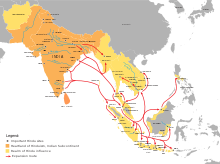
After the region came under contact with the Indian subcontinent c. 400 BCE, it began a gradual process of
The first Indian-influenced polities established in the region were the Pyu city-states that already existed circa second century BCE, located in inland Myanmar. It served as an overland trading hub between India and China.[82] Theravada Buddhism was the predominant religion of these city states, while the presence of other Indian religions such as Mahayana Buddhism and Hinduism were also widespread.[83][84] In the first century, the Funan states centered in Mekong Delta were established, encompassed modern-day Cambodia, southern Vietnam, Laos, and eastern Thailand. It became the dominant trading power in mainland Southeast Asia for about five centuries, provided passage for Indian and Chinese goods and assumed authority over the flow of commerce through Southeast Asia.[56] In maritime Southeast Asia, the first recorded Indianised kingdom was Salakanagara, established in western Java circa second century CE. This Hindu kingdom was known by the Greeks as Argyre (Land of Silver).[85]

By the fifth century CE, trade networking between East and West was concentrated in the maritime route. Foreign traders were starting to use new routes such as
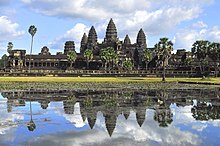
As Srivijaya influence in the region declined, The Hindu Khmer Empire experienced a golden age during the 11th to 13th century CE. The empire's capital
During the 13th century CE, the region experienced Mongol invasions, affected areas such as Vietnamese coast, inland Burma and Java. In 1258, 1285 and 1287, the Mongols tried to invade Đại Việt and Champa.[91] The invasions were unsuccessful, yet both Dai Viet and Champa agreed to become tributary states to Yuan dynasty to avoid further conflicts.[92] The Mongols also invaded Pagan Kingdom in Burma from 1277 to 1287, resulted in fragmentation of the Kingdom and rise of smaller Shan States ruled by local chieftains nominally submitted to Yuan dynasty.[93][94] However, in 1297, a new local power emerged. Myinsaing Kingdom became the real ruler of Central Burma and challenged the Mongol rule. This resulted in the second Mongol invasion of Burma in 1300, which was repulsed by Myinsaing.[95][96] The Mongols would later in 1303 withdrawn from Burma.[97] In 1292, The Mongols sent envoys to Singhasari Kingdom in Java to ask for submission to Mongol rule. Singhasari rejected the proposal and injured the envoys, enraged the Mongols and made them sent a large invasion fleet to Java. Unbeknownst to them, Singhasari collapsed in 1293 due to a revolt by Kadiri, one of its vassals. When the Mongols arrived in Java, a local prince named Raden Wijaya offered his service to assist the Mongols in punishing Kadiri. After Kadiri was defeated, Wijaya turned on his Mongol allies, ambushed their invasion fleet and forced them to immediately leave Java.[98][99]
After the departure of the Mongols, Wijaya established the
Spread of Islam

There are several theories to the
Trade and colonisation

Trade among Southeast Asian countries has a long tradition. The consequences of colonial rule, struggle for independence, and in some cases war influenced the economic attitudes and policies of each country.[108]
Chinese
From 111 BC to 938 AD northern Vietnam was under Chinese rule. Vietnam was successfully governed by a series of Chinese dynasties including the
. Records from Magellan's voyage show that Brunei possessed more cannon than European ships, so the Chinese must have been trading with them.[57]Malaysian legend has it that a Chinese Ming emperor sent a princess, Hang Li Po, to Malacca, with a retinue of 500, to marry Sultan Mansur Shah after the emperor was impressed by the wisdom of the sultan. Hang Li Poh's Well (constructed 1459) is now a tourist attraction there, as is Bukit Cina, where her retinue settled.
The strategic value of the
European
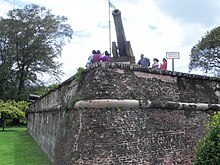
Western influence started to enter in the 16th century, with the arrival of the Portuguese in Malacca,
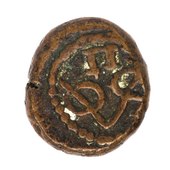
European explorers were reaching Southeast Asia from the west and from the east. Regular trade between the ships sailing east from the Indian Ocean and south from mainland Asia provided goods in return for natural products, such as honey and hornbill beaks from the islands of the archipelago. Before the eighteenth and nineteenth century, the Europeans mostly were interested in expanding trade links. For the majority of the populations in each country, there was comparatively little interaction with Europeans and traditional social routines and relationships continued. For most, a life with subsistence-level agriculture, fishing and, in less developed civilisations, hunting and gathering was still hard.[109]
Europeans brought Christianity allowing Christian missionaries to become widespread. Thailand also allowed Western scientists to enter its country to develop its own education system as well as start sending Royal members and Thai scholars to get higher education from Europe and Russia.
Japanese
During World War II,
Indian
Gujarat, India had a flourishing trade relationship with Southeast Asia in the 15th and 16th centuries.[107] The trade relationship with Gujarat declined after the Portuguese invasion of Southeast Asia in the 17th century.[107]
American
The United States took the Philippines from Spain in 1898. Internal autonomy was granted in 1934, and independence in 1946.[124]
Contemporary history
Most countries in the region maintain national autonomy. Democratic forms of government are practised in most Southeast Asian countries and human rights is recognised but dependent on each nation state. Socialist or communist countries in Southeast Asia include Vietnam, Laos. ASEAN provides a framework for the integration of commerce and regional responses to international concerns.
China has asserted broad claims over the
Geography

Indonesia is the largest country in Southeast Asia and is also the largest archipelago in the world by size (according to the
The South China Sea is the major body of water within Southeast Asia. The Philippines, Vietnam, Malaysia, Brunei, Indonesia, and Singapore, have integral rivers that flow into the South China Sea.
Boundaries
Geographically, Southeast Asia is bounded to the southeast by the Australian continent, the boundary between these two regions is most often considered to run through Wallacea.
Geopolitically, the boundary lies between Papua New Guinea and the Indonesian region of Western New Guinea (Papua and West Papua). Both countries share the island of New Guinea.
Islands to the east of the Philippines make up the region of Micronesia. These islands are not biogeographically, geologically or historically linked to mainland Asia, and are considered part of Oceania by the United Nations, The World Factbook and other organisations.[128] The Oceania region is politically represented through the Pacific Islands Forum, a governing body which, up until 2022, included Australia, New Zealand and all independent territories in Melanesia, Micronesia and Polynesia. Several countries of Maritime Southeast Asia, such as Indonesia and the Philippines, are dialogue partners of the Pacific Islands Forum, but none have full membership.[129]
Maritime Southeast Asia was often grouped with Australia and Oceania in the mid to late 1800s, rather than with mainland Asia.[130] The term Oceania came into usage at the beginning of the 1800s, and the earlier definitions predated the advent of concepts such as Wallacea.
The non-continental Australian external territories of
Climate

Most of Southeast Asia have a tropical climate that is hot and humid all year round with plentiful rainfall. The majority of Southeast Asia has a wet and dry season caused by seasonal shifts in winds or monsoons. The tropical rain belt causes additional rainfall during the monsoon season. The rainforest is the second largest on Earth (with the Amazon rainforest being the largest). Exceptions to the typical tropical climate and forest vegetation are:
- Northern Vietnam (including cold waves which move from the northeast and the Siberian High
- the northern part of Central Vietnam also is occasionally influenced by cold waves
- mountain areas in the northern region and the higher islands, where high altitudes lead to milder temperatures
- the “dry zone” of central Myanmar in the rain shadow of the Arakan Mountains, where annual rainfall can be as low as 600 millimetres or 24 inches, which under the hot temperatures that prevail is dry enough to qualify as semi-arid
Climate change
Southeast Asia is one of the most vulnerable regions to climate change in the world.[138][139] Climate change will have a big effect on agriculture in Southeast Asia such as irrigation systems will be affected by changes in rainfall and runoff, and subsequently, water quality and supply.[140] Climate change is impacting agriculture, threatening food security, and is compounded by the disruptions caused by the COVID-19 pandemic.[141] Climate change is also likely to pose a serious threat to the fisheries industry in Southeast Asia.[138] Despite being one of the most vulnerable regions to the effects of climate change in the world, Southeast Asian countries are lagging behind in terms of their climate mitigation measures.[139]
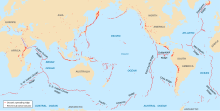
Environment

The vast majority of Southeast Asia falls within the warm, humid tropics, and its climate generally can be characterised as monsoonal. The animals of Southeast Asia are diverse; on the islands of Borneo and Sumatra, the orangutan, the Asian elephant, the Malayan tapir, the Sumatran rhinoceros and the Bornean clouded leopard can also be found. Six subspecies of the binturong or bearcat exist in the region, though the one endemic to the island of Palawan is now classed as vulnerable.

Tigers of three different subspecies are found on the island of Sumatra (the Sumatran tiger), in peninsular Malaysia (the Malayan tiger), and in Indochina (the Indochinese tiger); all of which are endangered species.
The Komodo dragon is the largest living species of lizard and inhabits the islands of Komodo, Rinca, Flores, and Gili Motang in Indonesia.

The
The
The
Birds such as the green peafowl and drongo live in this subregion as far east as Indonesia. The babirusa, a four-tusked pig, can be found in Indonesia as well. The hornbill was prized for its beak and used in trade with China. The horn of the rhinoceros, not part of its skull, was prized in China as well.
The Indonesian Archipelago is split by the Wallace Line. This line runs along what is now known to be a tectonic plate boundary, and separates Asian (Western) species from Australasian (Eastern) species. The islands between Java/Borneo and Papua form a mixed zone, where both types occur, known as Wallacea. As the pace of development accelerates and populations continue to expand in Southeast Asia, concern has increased regarding the impact of human activity on the region's environment. A significant portion of Southeast Asia, however, has not changed greatly and remains an unaltered home to wildlife. The nations of the region, with only a few exceptions, have become aware of the need to maintain forest cover not only to prevent soil erosion but to preserve the diversity of flora and fauna. Indonesia, for example, has created an extensive system of national parks and preserves for this purpose. Even so, such species as the Javan rhinoceros face extinction, with only a handful of the animals remaining in western Java.
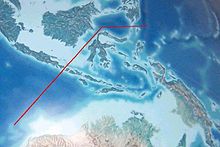
The shallow waters of the
The trees and other plants of the region are tropical; in some countries where the mountains are tall enough, temperate-climate vegetation can be found. These rainforest areas are currently being logged-over, especially in Borneo.
While Southeast Asia is rich in flora and fauna,
The
Economy

Even prior to the penetration of European interests, Southeast Asia was a critical part of the world trading system. A wide range of commodities originated in the region, but especially important were spices such as pepper, ginger, cloves, and nutmeg. The spice trade initially was developed by Indian and Arab merchants, but it also brought Europeans to the region. First,
The
In 2022, Malaysian petroleum industry through its oil and gas company, Petronas, was ranked eighth in the world by the Brandirectory.[149]
Seventeen telecommunications companies contracted to build the Asia-America Gateway submarine cable to connect Southeast Asia to the US[150] This is to avoid disruption of the kind caused by the cutting of the undersea cable from Taiwan to the US in the 2006 Hengchun earthquakes.

Tourism has been a key factor in economic development for many Southeast Asian countries, especially Cambodia. According to UNESCO, "tourism, if correctly conceived, can be a tremendous development tool and an effective means of preserving the cultural diversity of our planet."[151] Since the early 1990s, "even the non-ASEAN nations such as Cambodia, Laos, Vietnam and Burma, where the income derived from tourism is low, are attempting to expand their own tourism industries."[152] In 1995, Singapore was the regional leader in tourism receipts relative to GDP at over 8%. By 1998, those receipts had dropped to less than 6% of GDP while Thailand and Lao PDR increased receipts to over 7%. Since 2000, Cambodia has surpassed all other ASEAN countries and generated almost 15% of its GDP from tourism in 2006.[153] Furthermore, Vietnam is considered as a growing power in Southeast Asia due to its large foreign investment opportunities and the booming tourism sector.
By the early 21st century,
Stock markets in Southeast Asia have performed better than other bourses in the Asia-Pacific region in 2010, with the Philippines'
Southeast Asia's GDP per capita is US$4,685 according to a 2020 International Monetary Fund estimates, which is comparable to South Africa, Iraq, and Georgia.[160]
| Country | Currency | Nominal GDP (2020) $ billion[162] |
GDP per capita (2020)[160] |
GDP growth (2020)[163] |
Inflation (2020)[164] |
Main industries | |
|---|---|---|---|---|---|---|---|
| B$ Brunei dollar | 437,479 | $10.647 | $23,117 | 0.1% | 0.3% | Petroleum, Petrochemicals, Fishing | |
| ៛ US Dollar
|
16,718,965 | $26.316 | $1,572 | -2.8% | 2.5% | Clothing, Gold, Agriculture | |
| US$ US dollar | 1,318,445 | $1.920 | $1,456 | -6.8% | 0.9% | Petroleum, Coffee, Electronics | |
| Rp Rupiah | 270,203,917[161] | $1,088.768 | $4,038 | -1.5% | 2.1% | Coal, Petroleum, Palm oil | |
| ₭ Kip | 7,275,560 | $18.653 | $2,567 | 0.2% | 6.5% | Copper, Electronics, Tin | |
| RM Ringgit | 32,365,999 | $336.330 | $10,192 | -6% | -1.1% | Electronics, Petroleum, Petrochemicals, Palm oil, Automotive | |
| K Kyat
|
54,409,800 | $70.890 | $1,333 | 2% | 6.1% | Natural gas, Agriculture, Clothing | |
| ₱ Peso | 109,581,078 | $367.362 | $3,373 | -8.3% | 2.4% | Electronics, Timber, Automotive | |
| S$ Singapore dollar | 5,850,342 | $337.451 | $58,484 | -6% | -0.4% | Electronics, Petroleum, Chemicals | |
| ฿ Baht | 69,799,978 | $509.200 | $7,295 | -7.1% | -0.4% | Electronics, Automotive, Rubber | |
| ₫ Đồng | 97,338,579 | $340.602 | $3,498 | 2.9% | 3.8% | Electronics, Clothing, Petroleum |
Energy
Traditionally, the Southeast Asian economy has heavily relied on fossil fuels. However, it has begun transitioning towards clean energy. The region possesses significant renewable energy potential, including solar, wind, hydro, and pumped hydro energy storage. Modeling indicates that it could achieve a 97% share of solar and wind energy in the electricity mix at competitive costs ranging from $US 55 to $115 per megawatt-hour.[165]
The energy transition in Southeast Asia can be characterized as demanding, doable, and dependent.[166] This implies the presence of substantial challenges, including financial, technical, and institutional barriers. However, it is feasible, as evidenced by Vietnam's remarkable achievement of installing about 20 GW of solar and wind power in just three years.[167] International cooperation plays a crucial role in facilitating this transition.[166]
Demographics

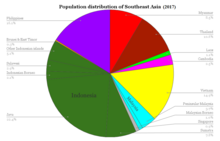
Southeast Asia has an area of approximately 4,500,000 square kilometres (1,700,000 sq mi). As of 2021, around 676 million people live in the region, more than a fifth live (143 million) on the Indonesian island of Java, the most densely populated large island in the world. Indonesia is the most populous country with 274 million people (~40% of South East Asia), and also the fourth most populous country in the world. The distribution of the religions and people is diverse in Southeast Asia and varies by country. Some 30 million overseas Chinese also live in Southeast Asia, most prominently in Christmas Island, Indonesia, Malaysia, the Philippines, Singapore, and Thailand, and also as the Hoa in Vietnam. People of Southeast Asian origins are known as Southeast Asians or Aseanites.
Ethnic groups

The peoples of Southeast Asia are mainly divided into four major ethnolinguistic groups: the
, Eurasians and Papuans, which also contributes to the diversity of peoples in the region.The
In Malaysia, the country is demographically divided into
Within the Philippines, the country has no majority ethnic groups; but the four largest ethnolinguistic groups in the country are the
In mainland Southeast Asia, the
.Cambodia is one of the most homogeneous countries in the area, with
Religion
-
Spirit houses are common in areas of Southeast Asia where Animism is a held belief.
-
TheMother Temple of Besakih, one of Bali's most significant Balinese Hindutemples.
-
ThaiBuddhists in Chiang Mai, Thailand.
-
Devotees at the .
-
Islamic country with Shariarule.
-
Cebu Metropolitan Cathedral in Cebu City, Philippines, the ecclesiastical seat of the Roman Catholic Archdiocese of Cebu
-
AProtestant church in Indonesia. Indonesia has the largest Protestant populationin Southeast Asia.
Countries in Southeast Asia practice many different religions and the region is home to many world religions including Abrahamic, Indian, East Asian and Iranian religions. By population,
There are approximately 190-205 million Buddhists in Southeast Asia, making it the second-largest religion in the region. Approximately 28 to 35% of the world's Buddhists reside in Southeast Asia. Buddhism is predominant in Vietnam, Thailand, Laos, Cambodia, Myanmar and Singapore, and adherents may come from Theravada or Mahayana schools. Ancestor worship and Confucianism are also widely practised in Vietnam and Singapore. Taoism and Chinese folk religions such as Mazuism are also widely practised by the overseas Chinese community in Malaysia, Singapore and Thailand. In certain cases, they may include Chinese or local deities in their worshipping practises such as Tua Pek Kong, Datuk Keramat and many more.
Christianity is predominant in the Philippines, eastern Indonesia, East Malaysia, and East Timor. The Philippines has the largest Roman Catholic population in Asia.[171] East Timor is also predominantly Roman Catholic due to a history of Indonesian[172] and Portuguese rule. In October 2019, the number of Christians, both Catholic and Protestant, in Southeast Asia reached 156 million, of which 97 million came from the Philippines, 29 million from Indonesia, 11 million from Vietnam, and the rest from Malaysia, Myanmar, East Timor, Singapore, Laos, Cambodia and Brunei. In addition, Eastern Orthodox Christianity can also be found in the region. In addition, Judaism is practised in certain countries such as in the Philippines, Singapore and Indonesia due to the presence of Jewish diaspora. There is a small population of Parsis in Singapore who practise Zoroastrianism, and Baháʼí is also practised by very small population in Malaysia, Vietnam, Singapore and Thailand.
No individual Southeast Asian country is religiously homogeneous. Some groups are protected de facto by their isolation from the rest of the world.
The religious composition for each country is as follows: Some values are taken from the
| Country | Religions |
|---|---|
| Islam (81%), Buddhism, Christianity, others (indigenous beliefs, etc.) | |
| Buddhism (97%), Islam, Christianity, Animism, others | |
| Roman Catholicism (97%), Protestantism, Islam, Hinduism, Buddhism | |
| Islam (87%), Protestantism (7.6%), Roman Catholicism (3.12%), Hinduism (1.74%), Buddhism (0.77%), Confucianism (0.03%), others (0.4%)[175][176] | |
| Buddhism (67%), Animism, Christianity, others | |
| Islam (61.3%), Buddhism, Christianity, Hinduism, Animism | |
| Buddhism (89%), Islam, Christianity, Hinduism, Animism, others | |
| Roman Catholicism (80.6%), Islam (6.9%-11%),[177] Evangelicals (2.7%), Iglesia ni Cristo (Church of Christ) (2.4%), Members Church of God International (1.0%), Other Protestants (2.8%), Buddhism (0.05%-2%),[178] Animism (0.2%-1.25%), others (1.9%)[179] | |
| Buddhism (31.1%), Christianity (18.9%), Islam (15.6%), Taoism (8.8%), Hinduism (5%), others (20.6%) | |
| Buddhism (93.5%), Islam (5.4%), Christianity (1.13%), Hinduism (0.02%), others (0.003%) | |
| Vietnamese folk religion (45.3%), Buddhism (16.4%), Christianity (8.2%), Other (0.4%), Unaffiliated (29.6%)[180] |
Languages
Each of the languages has been influenced by cultural pressures due to trade, immigration, and historical colonisation as well. There are nearly 800 native languages in the region.
The language composition for each country is as follows (with official languages in bold):
| Country/Region | Languages |
|---|---|
| Malay, English, Chinese, Tamil, Indonesian and indigenous Bornean dialects ( Murutic language, Lun Bawang.)[181]
| |
| Khmer, English, French, Teochew, Vietnamese, Cham, Mandarin, others[182] | |
| Portuguese, Tetum, Mambae, Makasae, Tukudede, Bunak, Galoli, Kemak, Fataluku, Baikeno, others[183] | |
| Indonesian, .
Indonesia has over 700 languages in over 17,000 islands across the archipelago, making Indonesia the second most linguistically diverse country on the planet,[184] slightly behind Papua New Guinea. The official language of Indonesia is Indonesian (Bahasa Indonesia), widely used in educational, political, economic, and other formal situations. In daily activities and informal situations, most Indonesians speak in their local language(s). For more details, see: Languages of Indonesia. | |
| Lao, French, Thai, Vietnamese, Hmong, Miao, Mien, Dao, Shan and others[185] | |
| Malaysian, Lundayeh/Lun Bawang, and others[186] see: Languages of Malaysia
| |
| Burmese, Shan, Kayin(Karen), Rakhine, Kachin, Chin, Mon, Kayah, Chinese and other ethnic languages.[187] | |
| Filipino ( and others | |
| English, Malay, Mandarin Chinese, Tamil, Hokkien, Teochew, Cantonese, Hakka, Japanese, Telugu, Malayalam, Punjabi, Indonesian, Boyanese, Buginese, Javanese, Balinese, Singlish creole and others[citation needed] | |
| Thai, Isan, Northern Khmer, Malay, Karen, Hmong, Teochew, Minnan, Hakka, Yuehai, Burmese, Mien, Tamil, Bengali, Urdu, Arabic, Shan, Lue, Phutai, Mon and others[188] | |
| Vietnamese, Cantonese, Khmer, Hmong, Tai, Cham and others[189] |
Cities
- Brunei-Muara (Bandar Seri Begawan/Muara),
 Brunei
Brunei - Kandal),
 Cambodia
Cambodia - Dili (Dili),
 East Timor
East Timor - Jabodetabek (Jakarta/Bogor/Depok/Tangerang/South Tangerang/Bekasi),
 Indonesia
Indonesia - West Bandung),
 Indonesia
Indonesia - Vientiane Prefecture (Vientiane/Tha Ngon),
 Laos
Laos - Greater Kuala Lumpur/Klang Valley (Kuala Lumpur/Selangor),
 Malaysia
Malaysia - George Town Conurbation (Penang/Kedah/Perak),
 Malaysia
Malaysia - Iskandar Malaysia (Johor),
 Malaysia
Malaysia - Yangon Region (Yangon/Thanlyin),
 Myanmar
Myanmar - Metro Manila (Manila/Quezon City/Makati/Taguig/Pasay/Caloocan and 11 others),
 Philippines
Philippines - Island Garden City of Samal),
 Philippines
Philippines - Metro Cebu (Cebu City/Mandaue/Lapu-Lapu City/Talisay City and 11 others),
 Philippines
Philippines - Singapore,
 Singapore
Singapore - Eastern Economic Corridor (Chachoengsao/Chonburi/Rayong),
 Thailand
Thailand - Đồng Nai),
 Vietnam
Vietnam - Hanoi Capital Region (Hà Nội/Hải Phòng/Hạ Long),
 Vietnam
Vietnam
- Night skylines
-
Kuala Lumpur, Malaysia
-
Bangkok, Thailand
-
Manila, Philippines
-
Ho Chi Minh City, Vietnam
-
Jakarta, Indonesia
Culture

The culture in Southeast Asia is diverse: on mainland Southeast Asia, the culture is a mix of Burmese, Cambodian, Laotian, Thai (

Rice paddy agriculture has existed in Southeast Asia for millennia, ranging across the subregion. Some dramatic examples of these rice paddies populate the Banaue Rice Terraces in the mountains of Luzon in the Philippines. Maintenance of these paddies is very labour-intensive. The rice paddies are well-suited to the monsoon climate of the region.
Stilt houses can be found all over Southeast Asia, from Thailand and Vietnam to Borneo, to Luzon in the Philippines, to Papua New Guinea. The region has diverse metalworking, especially in Indonesia. This includes weaponry, such as the distinctive kris, and musical instruments, such as the gamelan.
Influences
The region's chief cultural influences have been from some combination of
As a rule, the peoples who ate with their fingers were more likely influenced by the culture of India, for example, than the culture of China, where the peoples ate with
Arts

The
Puppetry and shadow plays were also a favoured form of entertainment in past centuries, a famous one being the
It has been pointed out that Khmer and Indonesian classical arts were concerned with depicting the life of the gods, but to the Southeast Asian mind, the life of the gods was the life of the peoples themselves—joyous, earthy, yet divine. The
Music

Traditional music in Southeast Asia is as varied as its many ethnic and cultural divisions. The main styles of traditional music include court music, folk music, music styles of smaller ethnic groups, and music influenced by genres outside the geographic region.
Of the court and folk genres, gong chime ensembles and orchestras make up the majority (the exception being lowland areas of Vietnam). Gamelan and angklung orchestras from Indonesia; piphat and pinpeat ensembles of Thailand and Cambodia; and the kulintang ensembles of the southern Philippines, Borneo, Sulawesi and Timor are the three main distinct styles of musical genres that have influenced other traditional musical styles in the region. String instruments are also popular in the region.
On 18 November 2010, UNESCO officially recognised the angklung as a Masterpiece of Oral and Intangible Heritage of Humanity, and encouraged the Indonesian people and government to safeguard, transmit, promote performances and to encourage the craftsmanship of angklung making.
Writing

The history of Southeast Asia has led to a wealth of different authors, from both within and without writing about the region.
Originally,
The antiquity of this form of writing extends before the invention of paper around the year 100 in China. Note each palm leaf section was only several lines, written longitudinally across the leaf, and bound by twine to the other sections. The outer portion was decorated. The alphabets of Southeast Asia tended to be abugidas, until the arrival of the Europeans, who used words that also ended in consonants, not just vowels. Other forms of official documents, which did not use paper, included Javanese copperplate scrolls. This material would have been more durable than paper in the tropical climate of Southeast Asia.
In Malaysia, Brunei, and Singapore, the Malay language is now generally written in the Latin script. The same phenomenon is present in Indonesian, although different spelling standards are utilised (e.g. 'Teksi' in Malay and 'Taksi' in Indonesian for the word 'Taxi').
The use of Chinese characters, in the past and present, is only evident in Vietnam and more recently, Singapore and Malaysia. The adoption of chữ Hán in Vietnam dates back to around 111 BC when it was occupied by the Chinese. A Vietnamese script called chữ Nôm used modified chữ Hán to express the Vietnamese language. Both chữ Hán and chữ Nôm were used up until the early 20th century.
Sports
See also
- Association of Southeast Asian Nations (ASEAN)
- Global Southeast
- List of current heads of state and government
- List of firsts in Southeast Asia
- Military build-up in Southeast Asia
- Pacific Asia
- Southeast Asia Treaty Organization
- Southeast Asian Games
- Tiger Cub Economies
Notes
- ^ A transcontinental country.
- ^ The great temple complex at Prambanan in Indonesia exhibit a number of similarities with the South Indian architecture.[88]
- ^ Also spelled South East Asia and South-East Asia, and also known as Southeastern Asia, South-eastern Asia or SEA
References
Citations
- ^ "World Population Prospects 2022". United Nations Department of Economic and Social Affairs, Population Division. Retrieved 17 July 2022.
- ^ "World Population Prospects 2022: Demographic indicators by region, subregion and country, annually for 1950-2100" (XSLX) ("Total Population, as of 1 July (thousands)"). United Nations Department of Economic and Social Affairs, Population Division. Retrieved 17 July 2022.
- ISBN 978-602-7643-73-4. Archived from the original(PDF) on 4 September 2015. Retrieved 9 May 2015.
- ^ a b c d e f "World Economic Outlook Database, April 2023". International Monetary Fund. April 2022. Retrieved 22 August 2023.
- ^ Klaus Kästle (10 September 2013). "Map of Southeast Asia Region". Nations Online Project. One World – Nations Online. Archived from the original on 20 September 2013. Retrieved 10 September 2013.
Southeast Asia is a vast subregion of Asia, roughly described as geographically situated east of the Indian subcontinent, south of China, and northwest of Australia. The region is located between the Indian Ocean and the Bay of Bengal in the west, the Philippine Sea, the South China Sea, and the Pacific Ocean in the east.
- PMID 26097277.
- ISBN 978-0-8144-0920-6.
- ^ "Population of Asia (2018)". worldometers.info. Archived from the original on 6 January 2019. Retrieved 30 December 2018.
- ^ Zide; Baker, Norman H.; Milton E. (1966). Studies in comparative Austroasiatic linguistics. Foreign Language Study.
{{cite book}}: CS1 maint: multiple names: authors list (link) - ^ "ASEAN Member States". ASEAN. Archived from the original on 10 August 2019. Retrieved 27 August 2017.
- ^ "The economic impact of colonialism". CEPR. 30 January 2017.
- ^ Paseng, Rohayati. "Research Guides: Southeast Asia Research Guide: Imperialism, Colonialism, & Nationalism". guides.library.manoa.hawaii.edu. Retrieved 9 July 2022.
- ^ Wallace, Alfred Russel (1869). The Malay Archipelago. London: Macmillan. p. 1.
- ISBN 978-0-226-46768-9.)
{{cite book}}: CS1 maint: multiple names: authors list (link - ^ Eliot, Joshua; Bickersteth, Jane; Ballard, Sebastian (1996). Indonesia, Malaysia & Singapore Handbook. New York City: Trade & Trade & Travel Publications.
- ISBN 978-981-4414-58-6.)
{{cite book}}: CS1 maint: multiple names: authors list (link - ^ S2CID 162530182.
- ^ a b "South-Eastern Asia Population (LIVE)". worldometers/. 6 February 2020. Archived from the original on 19 August 2013. Retrieved 6 February 2020.
- ^ "Human Development Report 2021/2022" (PDF). United Nations Development Programme. 8 September 2022. Retrieved 28 September 2022.
- ^ "East Asia/Southeast Asia :: Brunei – The World Factbook". cia.gov. Central Intelligence Agency. Archived from the original on 21 July 2015. Retrieved 11 November 2019.
- ^ "East Asia/Southeast Asia :: Cambodia – The World Factbook". cia.gov. Central Intelligence Agency. Archived from the original on 10 June 2021. Retrieved 11 November 2019.
- ^ "East Asia/Southeast Asia :: Timor-Leste – The World Factbook". cia.gov. Central Intelligence Agency. Archived from the original on 10 January 2021. Retrieved 11 November 2019.
- ^ "East Asia/Southeast Asia :: Indonesia – The World Factbook". cia.gov. Central Intelligence Agency. Archived from the original on 13 April 2021. Retrieved 11 November 2019.
- ^ "East Asia/Southeast Asia :: Laos – The World Factbook". cia.gov. Central Intelligence Agency. Archived from the original on 7 March 2021. Retrieved 11 November 2019.
- ^ "East Asia/Southeast Asia :: Malaysia – The World Factbook". cia.gov. Central Intelligence Agency. Archived from the original on 15 October 2021. Retrieved 16 October 2021.
- ^ "East Asia/Southeast Asia :: Burma – The World Factbook". cia.gov. Central Intelligence Agency. Archived from the original on 1 December 2021. Retrieved 11 November 2019.
- ^ "East Asia/Southeast Asia :: Philippines – The World Factbook". cia.gov. Central Intelligence Agency. Archived from the original on 20 August 2021. Retrieved 11 November 2019.
- ^ "East Asia/Southeast Asia :: Singapore – The World Factbook". cia.gov. Central Intelligence Agency. Archived from the original on 20 March 2021. Retrieved 11 November 2019.
- ^ "East Asia/Southeast Asia :: Thailand – The World Factbook". cia.gov. Central Intelligence Agency. Archived from the original on 10 June 2021. Retrieved 11 November 2019.
- ^ "East Asia/Southeast Asia :: Vietnam – The World Factbook". cia.gov. Central Intelligence Agency. Archived from the original on 10 June 2021. Retrieved 11 November 2019.
- ^ "United Nations Statistics Division - Standard Country and Area Codes Classifications (M49)". United Nations Statistics Division. 6 May 2015. Archived from the original on 13 July 2011. Retrieved 24 July 2010.
- ^ nationsonline.org, klaus kaestle-. "Singapore - A Country Profile - Nations Online Project". www.nationsonline.org. Retrieved 12 September 2022.
- ^ "Southeast Asia". Encyclopædia Britannica. Archived from the original on 24 April 2021. Retrieved 23 April 2021.
- ^ Baruah, Sanjib (2005). Durable Disorder: Understanding the Politics of Northeast India. Oxford University Press.
- ^ a b "Centennial Upper Air Observation in Hong Kong cum 70th Anniversary of King's Park Meteorological Station". Archived from the original on 19 November 2021. Retrieved 19 November 2021.
- ^ "Archived copy" (PDF). Archived (PDF) from the original on 19 November 2021. Retrieved 19 November 2021.
{{cite web}}: CS1 maint: archived copy as title (link) - ^ "Hong Kong Cultural Centre Open House on Sunday". Archived from the original on 2 September 2019. Retrieved 19 November 2021.
- ^ "Archived copy" (PDF). Archived (PDF) from the original on 19 November 2021. Retrieved 19 November 2021.
{{cite web}}: CS1 maint: archived copy as title (link) - ^ "VoiceLink38". Archived from the original on 19 November 2021. Retrieved 19 November 2021.
- ^ "Hong Kong Oratorio Society Holds Christmas Concert". Archived from the original on 19 November 2021. Retrieved 19 November 2021.
- ^ "Archived copy". Archived from the original on 19 November 2021. Retrieved 19 November 2021.
{{cite web}}: CS1 maint: archived copy as title (link) - ^ Friborg, Bastian (2010). Southeast Asia: Myth or Reality pg 4.
- ISBN 978-1-59140-725-6. Archivedfrom the original on 29 July 2020. Retrieved 15 May 2018.
- ^ United Nations Statistics Division – Standard Country and Area Codes Classifications. The UNSD notes that "the assignment of countries or areas to specific groupings is for statistical convenience".
- ^ "A Nation Reborn? Taiwan's Belated Recognition of Its Southeast Asian Heritage". thediplomat.com. Retrieved 1 July 2022.
- ^ ISBN 978-1-119-25154-5.
- PMID 28074030.
- ^ PMID 33753512.
- ^ Smith, Kiona N. (9 November 2018). "The world's oldest figurative drawing depicts a wounded animal". Ars Technica. Archived from the original on 9 November 2018. Retrieved 6 January 2022.
- S2CID 4302539.
- qpGraphanalysis confirmed this branching pattern, with the Leang Panninge individual branching off from the Near Oceanian clade after the Denisovan gene flow, although with the most supported topology indicating around 50% of a basal East Asian component contributing to the Leang Panninge genome (Fig. 3c, Supplementary Figs. 7–11).
- JSTOR 24936983.
- ISBN 978-0-19-857695-2.
- ISBN 978-0-300-10518-6.
- S2CID 49377747.
- ^ ISBN 978-0-7425-6761-0.
- ^ ISBN 978-0-06-621173-2
- ^ "Genetic 'map' of Asia's diversity". BBC News. 11 December 2009. Archived from the original on 29 January 2012. Retrieved 5 November 2010.
- ^ "Geneticist clarifies role of Proto-Malays in human origin". Malaysiakini. 25 January 2012. Archived from the original on 27 July 2018. Retrieved 27 August 2017.
- ^ Solheim, Journal of East Asian Archaeology, 2000, 2:1–2, pp. 273–284(12)
- ^ "Vietnam Tours". Archived from the original on 26 April 2013.
- ^ Nola Cooke, Tana Li, James Anderson – The Tongking Gulf Through History – Page 46 2011 -"Nishimura actually suggested the Đông Sơn phase belonged in the late metal age, and some other Japanese scholars argued that, contrary to the conventional belief that the Han invasion ended Đông Sơn culture, Đông Sơn artifacts, ..."
- ^ Vietnam Fine Arts Museum 2000 "... the bronze cylindrical jars, drums, Weapons and tools which were sophistically carved and belonged to the World-famous Đông Sơn culture dating from thousands of years; the Sculptures in the round, the ornamental architectural Sculptures ..."
- ^ Jan Gonda, The Indian Religions in Pre-Islamic Indonesia and their survival in Bali, in Handbook of Oriental Studies. Section 3 Southeast Asia, Religions, p. 1, at Google Books, pp. 1–54
- ISBN 978-1-57607-770-2. Archivedfrom the original on 14 June 2020. Retrieved 15 May 2018.
- ^ ISBN 978-0-7425-6762-7. Archivedfrom the original on 1 December 2019. Retrieved 15 May 2018.
- ^ ISBN 978-1-85984-016-0. Archivedfrom the original on 29 July 2020. Retrieved 15 May 2018.
- ^ ISBN 978-0-275-97361-2. Archivedfrom the original on 29 July 2020. Retrieved 15 May 2018.
- ISBN 978-90-04-04330-5. Archivedfrom the original on 5 February 2017. Retrieved 15 May 2018.
- ^ "Shaivism". obo. Archived from the original on 2 January 2018. Retrieved 6 January 2022.
- ISBN 978-1-315-43388-2. Archivedfrom the original on 31 July 2020. Retrieved 15 May 2018.
- ISBN 978-3-638-43208-5. Archivedfrom the original on 29 July 2020. Retrieved 15 May 2018.
- ISBN 978-1-119-06249-3. Archivedfrom the original on 29 July 2020. Retrieved 15 May 2018.
- ^ "The Global Religious Landscape". Pew Research Center's Religion & Public Life Project. 18 December 2012. Archived from the original on 19 July 2013. Retrieved 6 January 2022.
- ^ "Global Religious Landscape". The Pew Forum. Archived from the original on 1 January 2013. Retrieved 4 May 2014.
- S2CID 52084986.
- ISBN 978-1-78076-366-8.
- ISBN 978-0-7425-6762-7. Archivedfrom the original on 1 December 2019. Retrieved 15 May 2018.
- ISBN 978-981-4722-49-0. Archivedfrom the original on 31 July 2020. Retrieved 15 May 2018.
- ^ Postma, Antoon (27 June 2008). "The Laguna Copper-Plate Inscription: Text and Commentary". Philippine Studies. 40 (2): 182–203. Archived from the original on 10 October 2017. Retrieved 15 May 2018.
- ^ Viet Nam social sciences 2002 Page 42 Ủy ban khoa học xã hội Việt Nam – 2002 "The first period of cultural disruption and transformation: in and around the first millennium CE (that is, the period of Bac thuoc) all of Southeast Asia shifted into strong cultural exchanges with the outside world, on the one hand with Chinese ..."
- ISBN 978-93-5150-626-3. Archivedfrom the original on 29 July 2020. Retrieved 15 May 2018.
- ^ Aung-Thwin 2005: 31–34
- ^ Htin Aung 1967: 15–17
- ISBN 978-1-78462-885-7. Archivedfrom the original on 31 July 2020. Retrieved 15 May 2018.
- ^ R. C. Majumdar (1961), "The Overseas Expeditions of King Rājendra Cola", Artibus Asiae 24 (3/4), pp. 338–342, Artibus Asiae Publishers
- ISBN 978-93-80607-20-7. Archivedfrom the original on 29 July 2020. Retrieved 15 May 2018.
- ^ Nilakanta Sastri, K.A. The CōĻas, 1935, p. 709.
- PMID 17717084.
- ISBN 978-0-300-13793-4.
- ISBN 978-0-313-29622-2.
- ISBN 978-1-285-96570-3. Archivedfrom the original on 31 July 2020. Retrieved 15 May 2018.
- ^ Hardiman, John Percy (1900). Gazetteer of Upper Burma and the Shan States. superintendent, Government printing, Burma.
- ISBN 978-0-9817833-0-7. Archivedfrom the original on 29 July 2020. Retrieved 15 May 2018.
- ISBN 978-1-135-95501-4. Archivedfrom the original on 29 July 2020. Retrieved 15 May 2018.
- ISBN 978-0-595-22134-9. Archivedfrom the original on 29 July 2020. Retrieved 15 May 2018.
- ISBN 978-0-231-50004-3.
- ISBN 978-0-8133-4838-4. Archivedfrom the original on 29 July 2020. Retrieved 15 May 2018.
- ISBN 978-81-207-9223-4. Archivedfrom the original on 31 July 2020. Retrieved 15 May 2018.
- ISBN 978-981-3018-26-6.
- ISBN 978-0-85709-449-0. Archivedfrom the original on 29 July 2020. Retrieved 15 May 2018.
- ISBN 978-0-8248-3052-6. Archivedfrom the original on 29 July 2020. Retrieved 15 May 2018.
- ISBN 978-1-4796-0544-6. Archivedfrom the original on 29 July 2020. Retrieved 15 May 2018.
- ISBN 978-0-313-36325-2. Archivedfrom the original on 29 July 2020. Retrieved 15 May 2018.
- ISBN 978-1-78074-452-0. Archivedfrom the original on 29 July 2020. Retrieved 15 May 2018.
- ^ Wang Ma, Rosey (2003). Chinese Muslims in Malaysia: History and Development. Center for Asia-Pacific Area Studies, Academia Sinica. Archived from the original on 4 September 2015. Retrieved 1 April 2015.
- ^ a b c Prabhune, Tushar (27 December 2011). "Gujarat helped establish Islam in SE Asia". The Times of India. Ahmedabad. Archived from the original on 3 December 2019. Retrieved 15 May 2018.
- ISBN 978-1-107-50718-0.
- ISBN 978-1-107-50718-0.
- ^ "The Cruel Vivisections Japanese Performed on Filipinos in WWII".
- ^ "Vivisection on Filipinos admitted". 27 November 2006.
- ^ Harris, Sheldon H. "JAPANESE BIOMEDICAL EXPERIMENTATION DURING THE WORLD-WAR-II ERA" (PDF). laguardia.edu. Archived from the original (PDF) on 24 March 2023. Retrieved 15 April 2023.
- ^ Gold, Hal (2011). Unit 731 Testimony (1st ed.). New York: Tuttle Pub. p. 97. ISBN 978-1462900824.
- ^ "- The Japan Times". japantimes.co.jp. [permanent dead link]
- ^ "Unit 731: Japan's biological force". February 2002.
- ^ "The United States and the Japanese Mengele: Payoffs and Amnesty for Unit 731". 14 August 2006.
- ^ "Philippine Survivor Recounts Her Struggle As A 'Comfort Woman' For Wartime Japan". NPR.org. NPR. Retrieved 15 August 2021.
- ISBN 9789715425629. Retrieved 15 August 2021.
- ^ "The mystery of the missing comfort woman statue". Vera Files. 27 August 2019. Retrieved 15 August 2021.
- ^ Mosbergen, Dominique (29 August 2017). "Harrowing Story Of Filipina Women Enslaved In Japan's Wartime Rape Camps". Huffington Post. New York, New York. Retrieved 30 March 2018.
"Filipino 'comfort women' survivors stage rally in Manila". ABS CBN News. Kyodo News. 20 November 2015. Retrieved 30 March 2018.
Whaley, Floyd (29 January 2016). "In Philippines, World War II's Lesser-Known Sex Slaves Speak Out". The New York Times. Retrieved 30 March 2018. - ^ "Voices of the "Comfort Women": The Power Politics Surrounding the UNESCO Documentary Heritage". March 2021.
- ^ "Archived copy". lcweb2.loc.gov. Archived from the original on 30 October 2004. Retrieved 6 January 2022.
{{cite web}}: CS1 maint: archived copy as title (link) - ISBN 978-0-394-75172-6.[page needed]
- ^ H. W. Brands, Bound to Empire: The United States and the Philippines: 1890-1990 (1992)
- ^ Liow, Joseph Chinyong (12 July 2016). "What does the South China Sea ruling mean, and what's next?". Brookings. Archived from the original on 23 June 2018. Retrieved 6 January 2022.
- ^ Euan Graham, The Hague Tribunal's South China Sea Ruling: Empty Provocation or Slow-Burning Influence? Archived 10 March 2018 at the Wayback Machine, Lowy Institute for International Policy (18 August 2016).
- ^ Davis, Lee (1992). Natural disasters: from the Black Plague to the eruption of Mt. Pinatubo. New York, NY: Facts on File Inc.. pp. 300–301.
- ^ a b "Methodology: Standard country or area codes for statistical use (M49)". United Nations Statistics Division.
- ^ "The Pacific Islands Forum – Forum Sec".
- ISBN 9780520207424. Retrieved 4 June 2022.
As is explained in note 71 (this chapter), insular Southeast Asia was often grouped with Oceania instead of with Asia in the middle and late 1800s.
- ISBN 9781610692502. Retrieved 10 July 2022.
- ^ "Christmas Island – Australia's Gem In The Indian Ocean".
- ^ "Christmas and Cocos Keeling Islands Birding Guide" (PDF). Archived from the original (PDF) on 19 August 2014.
- ^ "BMR Cruise 107: Seabed Morphology and Offshore Resources around Christmas Island, Indian Ocean". Product catalogue.
- ^ "Conservation values in Commonwealth waters of the Christmas and Cocos (Keeling) Island remote Australian territories" (PDF). CSIRO. August 2009. Archived (PDF) from the original on 5 March 2021. Retrieved 1 June 2022.
- ^ "Cocos (Keeling) Islands - The World Factbook". Cia.gov. 24 June 2022. Retrieved 10 July 2022.
- ^ "Christmas Island". Central Intelligence Agency. 24 June 2022 – via CIA.gov.
- ^ a b Overland, Indra (6 November 2017). Impact of Climate Change on ASEAN International Affairs: Risk and Opportunity Multiplier. Archived from the original on 28 July 2020. Retrieved 6 January 2022.
- ^ ISSN 2666-2787.
- ^ "Climate Change Impacts - South East Asia". Archived from the original on 29 August 2017.
- S2CID 234149666.
- ^ "Climate Reality Watch Party 2016". 13 December 2012. Archived from the original on 20 August 2018. Retrieved 15 May 2018.
- ISBN 978-0-521-83930-3.
- ^ Young, Emma. "Biodiversity wipeout facing South East Asia". New Scientist. Retrieved 6 January 2022.
- ^ 2013 Southeast Asian haze#Air Pollution Index readings
- ISBN 978-1-107-50718-0.
- ISBN 978-0-684-82289-1.
- ISBN 978-0-684-82289-1.
- ^ "Oil & Gas 50 2022 | Brand Value Ranking League Table | Brandirectory". brandirectory.com. Retrieved 7 February 2023.
- ^ Sean Yoong (27 April 2007). "17 Firms to Build $500M Undersea Cable". International Business Times. Archived from the original on 27 September 2007. Retrieved 28 July 2007.
- ^ Background overview of The National Seminar on Sustainable Tourism Resource Management Archived 24 March 2012 at the Wayback Machine, Phnom Penh, 9–10 June 2003.
- ^ Hitchcock, Michael, et al. Tourism in South-East Asia. New York: Routledge, 1993
- ^ WDI Online
- ^ "About the G20". G20. Archived from the original on 11 January 2021. Retrieved 27 January 2021.
- ^ "Indonesia Datasets - World Economics Outlook (October 2020)". IMF. October 2020. Archived from the original on 27 January 2021. Retrieved 27 January 2021.
- ^ "Report for Selected Countries and Subjects". IMF. Retrieved 14 February 2023.
- ^ a b "Mercer's 2020 Cost of Living Survey | Mercer ASEAN". www.asean.mercer.com. Archived from the original on 14 February 2023. Retrieved 14 February 2023.
- ^ "SE Asia Stocks-Jakarta, Manila hit record highs, others firm". Reuters. 27 September 2010. Archived from the original on 2 December 2020. Retrieved 2 July 2017.
- ^ Bull Market Lifts PSE Index to Top Rank Among Stock Exchanges in Asia | Manila Bulletin. Mb.com.ph (24 September 2010). Retrieved on 17 October 2011.
- ^ a b "World Economic Outlook (December 2020) – Nominal GDP per capita". IMF. Archived from the original on 11 January 2020. Retrieved 25 January 2021.
- ^ a b "Hasil Sensus Penduduk 2020" (PDF) (in Indonesian). Statistics Indonesia. 21 January 2021. p. 9. Archived (PDF) from the original on 22 January 2021. Retrieved 21 January 2021.
- ^ "World Economic Outlook (December 2020) – Nominal GDP". IMF. Archived from the original on 19 October 2019. Retrieved 25 January 2021.
- ^ "World Economic Outlook (December 2020) – Real GDP growth". IMF. Archived from the original on 14 November 2020. Retrieved 25 January 2021.
- ^ "World Economic Outlook (December 2020) – Inflation rate, average consumer prices". IMF. Archived from the original on 14 November 2020. Retrieved 25 January 2021.
- ISSN 0360-5442.
- ^ ISSN 2050-2680.
- ISSN 0973-0826.
- ^ "Religious Composition by Country, 2010-2050". www.pewforum.org. Archived from the original on 21 December 2019. Retrieved 18 October 2020.
- ^ "Malaysia - Religion | Britannica". www.britannica.com. Retrieved 14 February 2023.
- ^ "Home". www.mfa.gov.bn. Retrieved 14 February 2023.
- ^ "5 facts about Catholicism in the Philippines". Pew Research Center. Archived from the original on 25 June 2021. Retrieved 5 July 2021.
- ISBN 978-0-300-10518-6.
- ^ McKirdy, Euan; Pokharel, Sugam (21 November 2018). "North Sentinel Island tribespeople believed to have killed trespassing US 'missionary'". CNN. Archived from the original on 12 November 2020. Retrieved 6 January 2022.
- ^ "Field Listing – Religions". CIA Factbook. Archived from the original on 20 December 2018. Retrieved 24 February 2007.
- ^ "Indonesia", The World Factbook, Central Intelligence Agency, 29 December 2021, archived from the original on 13 April 2021, retrieved 6 January 2022
- ^ "Statistik Umat Menurut Agama di Indonesia" (in Indonesian). Ministry of Religious Affairs. 15 May 2018. Archived from the original on 3 September 2020. Retrieved 24 September 2020.
- ^ "National Commission on Muslim Filipinos". ncmf.gov.ph. Archived from the original on 19 November 2016. Retrieved 14 July 2016.
- ^ BuddhaNet. "World Buddhist Directory – Presented by BuddhaNet.Net". buddhanet.info. Archived from the original on 13 March 2021. Retrieved 23 October 2014.
- ^ "2015 Philippine Statistical Yearbook" (PDF). psa.gov.ph. Philippine Statistical Authority. October 2015. Archived (PDF) from the original on 11 October 2016. Retrieved 26 July 2020.
- ^ "Table: Religious Composition by Country, in Percentages". 18 December 2012. Archived from the original on 18 May 2014. Retrieved 17 March 2015.
- ^ "Brunei", The World Factbook, Central Intelligence Agency, 29 December 2021, archived from the original on 21 July 2015, retrieved 6 January 2022
- ^ "Cambodia", The World Factbook, Central Intelligence Agency, 28 December 2021, archived from the original on 10 June 2021, retrieved 6 January 2022
- ^ "Timor-Leste", The World Factbook, Central Intelligence Agency, 29 December 2021, archived from the original on 18 January 2021, retrieved 6 January 2022
- ^ "Top 20 Countries by Number of Languages Spoken". vistawide.com. Archived from the original on 30 December 2018. Retrieved 28 May 2016.
- ^ "Laos", The World Factbook, Central Intelligence Agency, 28 December 2021, archived from the original on 7 March 2021, retrieved 6 January 2022
- ^ "Malaysia", The World Factbook, Central Intelligence Agency, 28 December 2021, archived from the original on 27 January 2021, retrieved 6 January 2022
- ^ "Country: Myanmar (Burma)". Joshua Project. Archived from the original on 11 September 2018. Retrieved 15 May 2018.
- ^ "Thailand", The World Factbook, Central Intelligence Agency, 28 December 2021, archived from the original on 10 June 2021, retrieved 6 January 2022
- ^ "Vietnam", The World Factbook, Central Intelligence Agency, 28 December 2021, archived from the original on 10 June 2021, retrieved 6 January 2022
- ^ "Introduction to Vietnamese culture" (PDF). UNESCO. Archived (PDF) from the original on 17 June 2017. Retrieved 23 August 2021.
- ISSN 0219-8126. Archived from the original(PDF) on 21 October 2012. Retrieved 22 July 2014.
Further reading
- Acharya, Amitav. The making of Southeast Asia: International relations of a region (Cornell UP, 2013).
- Ang, Cheng Guan. Southeast Asia After the Cold War: A Contemporary History (Singapore: NUS Press, 2019) online review
- Ang, Cheng Guan. Southeast Asia's Cold War: An Interpretive History (University of Hawai’i Press, 2018). online review Archived 7 July 2021 at the Wayback Machine
- Barwise, J. M., and Nicholas J. White. A traveller's history of Southeast Asia (2002) online
- Cady, John F. Southeast Asia: its historical development (McGraw-Hill, 1964) online
- Cady, John F. The roots of French imperialism in Eastern Asia (1954) online
- Coedes, George. The Making of South East Asia (2nd ed. U of California Press, 1983).
- Dutt, Ashok K. Southeast Asia: A Ten Nation Region (1996) excerpt
- Embree, Ainslie T., ed. Encyclopedia of Asian history (1988)
- Heidhues, Mary Somers. Southeast Asia : a concise history (2000) online
- Leinbach, Thomas R., and Richard Ulack. Southeast Asia: diversity and development (Prentice Hall, 1999) online.
- Levinson, David, and Karen Christensen, eds. Encyclopedia of Modern Asia. (6 vol. Charles Scribner's Sons, 2002).
- Osborne, Milton. Region of revolt: focus on Southeast Asia (Elsevier, 2013). online
- Osborne, Milton (2010; first published in 1979). Southeast Asia: An Introductory History Archived 29 July 2020 at the ISBN 978-1-74237-302-7 online
- Osborne, Milton. River at risk: the Mekong and water politics of China and Southeast Asia (Longueville Media, 2004).
- Reid, Anthony (1999). Charting the Shape of Early Modern Southeast Asia Silkworm Books. ISBN 978-974-7551-06-8
- Swearer, Donald K. The Buddhist World of Southeast Asia (2nd ed. 2010) online
- Ulack, Richard, and Gyula Pauer. Atlas of Southeast Asia (Macmillan, 1989) online.
- Williams, Lea E. Southeast Asia : a history (1976) online
External links
- Topography of Southeast Asia in detail (PDF) (previous version)
- Southeast Asian Archive at the University of California, Irvine at archive.today (archived 12 December 2012)
- Southeast Asia Digital Library at Northern Illinois University
- "Documenting the Southeast Asian Refugee Experience", exhibit at the University of California, Irvine, Library at archive.today (archived 25 February 2003)
- Southeast Asia Visions, a collection of historical travel narratives Cornell University Library Digital Collection
- Official website of the ASEAN Tourism Association
- Art of Island Southeast Asia, a full text exhibition catalogue from The Metropolitan Museum of Art

